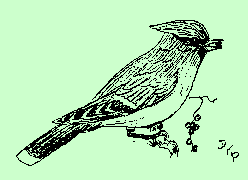|







|
. |
The Bohemian Waxwing

 The Bohemian (Bombycilla garrulus) is the larger of the two waxwings,
but is grayer and has no yellow on its belly. The wings have white and
yellow markings, and the under tail coverts are rusty. The overall color is
a beautiful chocolate mauve. These birds have a soft and sleek appearance,
and a crested head. The bright red waxy tips of the secondary feathers gives
it its name.
The Bohemian (Bombycilla garrulus) is the larger of the two waxwings,
but is grayer and has no yellow on its belly. The wings have white and
yellow markings, and the under tail coverts are rusty. The overall color is
a beautiful chocolate mauve. These birds have a soft and sleek appearance,
and a crested head. The bright red waxy tips of the secondary feathers gives
it its name.


 The call of the Bohemian is a lisping "Zr-e-e-e" which, according to
Peterson, is rougher than that of the Cedar Waxwing (B. cedrorum).
It has no song.
The call of the Bohemian is a lisping "Zr-e-e-e" which, according to
Peterson, is rougher than that of the Cedar Waxwing (B. cedrorum).
It has no song.

 The breeding habitat extends from Central Alaska south through Montana and
into southwest Alberta. The nest is made of bits of conifers, twigs, and
moss. Four to six pale blue dotted eggs are laid. In the winter, the
Bohemian appears sporadically in the northwestern states, and especially
in the Rocky Mountain area.
The breeding habitat extends from Central Alaska south through Montana and
into southwest Alberta. The nest is made of bits of conifers, twigs, and
moss. Four to six pale blue dotted eggs are laid. In the winter, the
Bohemian appears sporadically in the northwestern states, and especially
in the Rocky Mountain area.

 The waxwings are gregarious, flying about in large flocks, sometimes
numbering several hundred. Both insects and berries are in their diet. In
capturing insects, they behave like a skilled flycatcher.
The waxwings are gregarious, flying about in large flocks, sometimes
numbering several hundred. Both insects and berries are in their diet. In
capturing insects, they behave like a skilled flycatcher.

 John Kieran observed several arrange themselves on a cherry tree limb and
"passing a cherry from bill to bill, up and down the line, each bird
apparently too polite to swallow the cherry and put an end to the
performance."
John Kieran observed several arrange themselves on a cherry tree limb and
"passing a cherry from bill to bill, up and down the line, each bird
apparently too polite to swallow the cherry and put an end to the
performance."

 About two hundred came in late November (1965), and were observed flying
about in the trees. Flocks of these, including Cedar Waxwings, came often
to the grove of "cedars" in front of the old schoolhouse until these were
cut down, after which they never returned.
by Jennie Reynolds -- Monroe, Utah
About two hundred came in late November (1965), and were observed flying
about in the trees. Flocks of these, including Cedar Waxwings, came often
to the grove of "cedars" in front of the old schoolhouse until these were
cut down, after which they never returned.
by Jennie Reynolds -- Monroe, Utah
|
|

